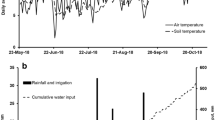Abstract
The long term impact of excreta return on some chemical and biological properties of a pasture soil fertilised with sulphur and phosphate was studied in a system that had been with or without excreta for 23 years. Excreta free areas that had developed under electric fencelines, and parallel transects in the paddocks, were sampled to provide this comparison. Sampling was to 300 mm depth in 0–75, 75–150 and 150–300 mm sections. Total carbon and nitrogen were 20% higher in the 0–150 mm soil layer of areas receiving excreta but did not differ in the 150–300 mm layer. Carbon:nitrogen ratios were similar in both systems as was mineralisable nitrogen, both absolutely and as a percentage of total in the 0–75 mm layer. Significantly more N was mineralised in the 75–150 mm layers of the areas receiving excreta but this was reversed in the 150–300 mm layer. Nitrification rate was higher in all layers of the excreta areas. Inorganic and organic P fractions did not differ significantly. Total P was significantly higher in the 0–75 mm layer and significantly lower in the 150–300 mm layer of the excreta areas. Exchangeable potassium was much higher throughout the excreta areas while this was offset by calcium. The sum of the cations was similar in both areas. Excreta affected most of the diagnostic soil tests used for fertiliser recommendations. The soil properties measured did not reflect clearly the differences in productivity that were obvious in the two areas. It is concluded that excreta return has a impact resulting in increased organic matter storage. Short-term effects of urine have a greater impact on productivity. The major effect is on the disposition of cations and available P.
Similar content being viewed by others
References
Ball PR & Ryden JC (1984) Nitrogen relationships in intensively managed temperate grasslands. Plant Soil 76: 23–33
Barrow NJ (1975) Chemical forms of inorganic phosphate in sheep faeces. Aust J Soil Res 13: 63–67
Carran RA & Theobald PW (1995) Nitrogen cycling processes and acidification of soils in grazed pastures receiving or not receiving excreta for 23 years. Aust J Soil Res 33: 525–534
Clark DA & Brougham RW (1978) Feed intake from grazing Friesian bulls. NZ Soc Anim Prod 38: 265–274
Cosgrove GP & Brougham RW (1988) Pasture strategies for dairy beef production. Proc NZ Grassl Assoc 49: 57–62
Early MSB, Cameron KC & Fraser PM(1998) The fate of potassium calcium and magnesium in simulated urine patches on irrigated dairy pasture. NZ J Agric Res 41: 117–125
Haynes RJ & Williams PH (1993) Nutrient cycling and soil fertility in the grazed pasture system. Adv Agron 49: 119–199
Haynes RJ & Williams PH (1992) Effect of superphosphate on accumulation of soil phosphorus and exchangeable cations on a grazed, irrigated pasture site. Plant Soil 142: 123–133
Hoglund JH, Crush JR, Brock JL, Ball R & Carran RA (1979) Nitrogen fixation in pasture. XII. General discussion. NZ J Exp Agric 7: 45–51
Hutton JB, Jury KE & Davies EB (1965) Studies of the nutritive value of dairy pastures. IV. The intake and utilisation of magnesium in pasture herbage by lactating dairy cattle. NZ J Agric Res 8: 479–496
Hutton JB, Jury KE & Davies EB (1967) Studies of the nutritive value of dairy pastures. V. The intake and utilisation of potassium, sodium, calcium, phosphorus and nitrogen in pasture herbage by lactating dairy cattle. NZ J Agric Res 10: 367–388
Sakadevan K, Hedley MJ & MacKay AD (1994) Leaching losses of nutrients from hill pastures grazed by sheep. In: Currie LD & Laganathan P (eds) The Efficient Use of Fertilizers in a Changing Environment: Reconciling Productivity and Sustainability. Occasional report No 7, pp 127–137. Fertilizer and Lime ResearchCentre, Massey University, Palmerston North
Saunders WMH & Williams EG (1955) Observations on the determination of total organic phosphorus in soils. J Soil Sci 6: 254–267
Searle PL (1986) The measurement of soil cation exchange properties using the single extraction, silver thiourea method: An evaluation using a range of New Zealand soils. Aust J Soil Res 24: 193–200
Sears PD (1953) Pasture growth and soil fertility 1. The influence of red and white clovers, superphosphate lime and sheep grazing, on pasture yields and botanical composition. NZ J Sci Tech 35(A): Supplement 1, 1–29
West CP, Mallarino AP, Wedin WF & Marks DB (1989) Spatial variability of soil chemical properties in grazed pastures. Soil Sci Soc Am J 53: 784–789
Williams PH & Haynes RJ (1992) Balance sheet of phosphorus sulphur and potassium in a grazed pasture supplied with superphosphate. Fert Res 31: 51–60
Young JL & Aldag RW (1982) Inorganic forms of nitrogen in soil. In: Stevenson FJ (ed) Nitrogen in Agricultural Soils. Agronomy Monograph 22. Madison, Wisc: American Society of Agronomy, 940 pp
Author information
Authors and Affiliations
Corresponding author
Rights and permissions
About this article
Cite this article
Carran, R., Theobald, P. Effects of excreta return on properties of a grazed pasture soil. Nutrient Cycling in Agroecosystems 56, 79–85 (2000). https://doi.org/10.1023/A:1009842727493
Issue Date:
DOI: https://doi.org/10.1023/A:1009842727493




